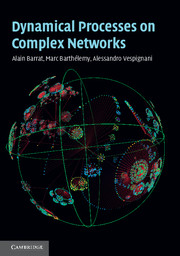Book contents
- Frontmatter
- Contents
- Preface
- Acknowledgements
- List of abbreviations
- 1 Preliminaries: networks and graphs
- 2 Networks and complexity
- 3 Network models
- 4 Introduction to dynamical processes: theory and simulation
- 5 Phase transitions on complex networks
- 6 Resilience and robustness of networks
- 7 Synchronization phenomena in networks
- 8 Walking and searching on networks
- 9 Epidemic spreading in population networks
- 10 Social networks and collective behavior
- 11 Traffic on complex networks
- 12 Networks in biology: from the cell to ecosystems
- 13 Postface: critically examining complex networks science
- Appendix 1 Random graphs
- Appendix 2 Generating functions formalism
- Appendix 3 Percolation in directed networks
- Appendix 4 Laplacian matrix of a graph
- Appendix 5 Return probability and spectral density
- References
- Index
13 - Postface: critically examining complex networks science
Published online by Cambridge University Press: 05 September 2012
- Frontmatter
- Contents
- Preface
- Acknowledgements
- List of abbreviations
- 1 Preliminaries: networks and graphs
- 2 Networks and complexity
- 3 Network models
- 4 Introduction to dynamical processes: theory and simulation
- 5 Phase transitions on complex networks
- 6 Resilience and robustness of networks
- 7 Synchronization phenomena in networks
- 8 Walking and searching on networks
- 9 Epidemic spreading in population networks
- 10 Social networks and collective behavior
- 11 Traffic on complex networks
- 12 Networks in biology: from the cell to ecosystems
- 13 Postface: critically examining complex networks science
- Appendix 1 Random graphs
- Appendix 2 Generating functions formalism
- Appendix 3 Percolation in directed networks
- Appendix 4 Laplacian matrix of a graph
- Appendix 5 Return probability and spectral density
- References
- Index
Summary
Although we have reviewed or mentioned more than 600 scientific works on equilibrium and non-equilibrium processes in complex networks, the present book is by no means intended as an exhaustive account of all research activities in network science. It would have been extremely easy to list more than twice as many scientific papers and, as we have stressed in several passages of this book, we have decided to focus our attention on that subset of network research that deals with dynamical processes in large-scale networks characterized by complex features such as largescale fluctuations and heterogeneities. This implies the selection of studies and approaches tailored to tackle the large-scale properties and asymptotic behavior of phenomena and, as a consequence, models that usually trade details and realism for generality and a high level of abstraction. This corresponds to a methodological approach that has its roots in statistical physics and has greatly contributed to generate an entire research area labeled in recent years as the “new science of networks” (Watts, 2004). As network science is an interdisciplinary endeavor, however, we do not want to overlook the criticisms raised by several authors to this “new science of networks” and to the statistical physics and complex systems approaches. These criticisms are articulated around several key points that are echoed in several commentaries and essays (see for instance Urry [2004], Keller [2005] and Mitzenmacher [2006]), and at the end of 12 long chapters we believe we are obliged to provide a discussion of some of these key points.
- Type
- Chapter
- Information
- Dynamical Processes on Complex Networks , pp. 294 - 297Publisher: Cambridge University PressPrint publication year: 2008



